Medical Education: Designing Communication Skills Training Report
VerifiedAdded on 2020/03/16
|12
|2854
|355
Report
AI Summary
This report delves into the crucial role of communication skills within medical education, particularly in an acute hospital setting. It emphasizes the need for effective communication between healthcare providers and patients, highlighting the importance of ethical and responsible interactions. The report outlines learning objectives designed to enhance communication skills, including the ability to communicate ethically, work effectively in groups, develop interpersonal skills, and address patient requirements formally. It then explores training development, discussing programs like 'The language of Caring for staff' and assessment tools such as SBAR. The implementation of these training programs is discussed, emphasizing the positive impact on patient care, trust, and satisfaction. The report also examines formative and summative evaluation methods to assess the effectiveness of communication skills training, ultimately aiming to improve the quality of healthcare services. The document is a comprehensive guide for medical students, offering insights into communication strategies and evaluation techniques within a hospital setting. It is contributed by a student to be published on the website Desklib.

Running head: MEDICAL EDUCATION
Name of the student
University name
Author’s note
Name of the student
University name
Author’s note
Paraphrase This Document
Need a fresh take? Get an instant paraphrase of this document with our AI Paraphraser

1
MEDICAL EDUCATION
Table of Contents
Introduction..................................................................................................................................2
Designing learning objectives for imparting communication skills............................................2
To communicate ethically , responsibly and effectively with the patients......................................3
To communicate effectively within a group to analyse the patient problem and devise a solution 3
To develop interpersonal communication competences..................................................................3
To deliver skills to address the patient requirements formally........................................................4
Training development..................................................................................................................4
Implementation of the training.....................................................................................................6
Formative and summative evaluation..........................................................................................7
Conclusion...................................................................................................................................8
References..................................................................................................................................10
MEDICAL EDUCATION
Table of Contents
Introduction..................................................................................................................................2
Designing learning objectives for imparting communication skills............................................2
To communicate ethically , responsibly and effectively with the patients......................................3
To communicate effectively within a group to analyse the patient problem and devise a solution 3
To develop interpersonal communication competences..................................................................3
To deliver skills to address the patient requirements formally........................................................4
Training development..................................................................................................................4
Implementation of the training.....................................................................................................6
Formative and summative evaluation..........................................................................................7
Conclusion...................................................................................................................................8
References..................................................................................................................................10
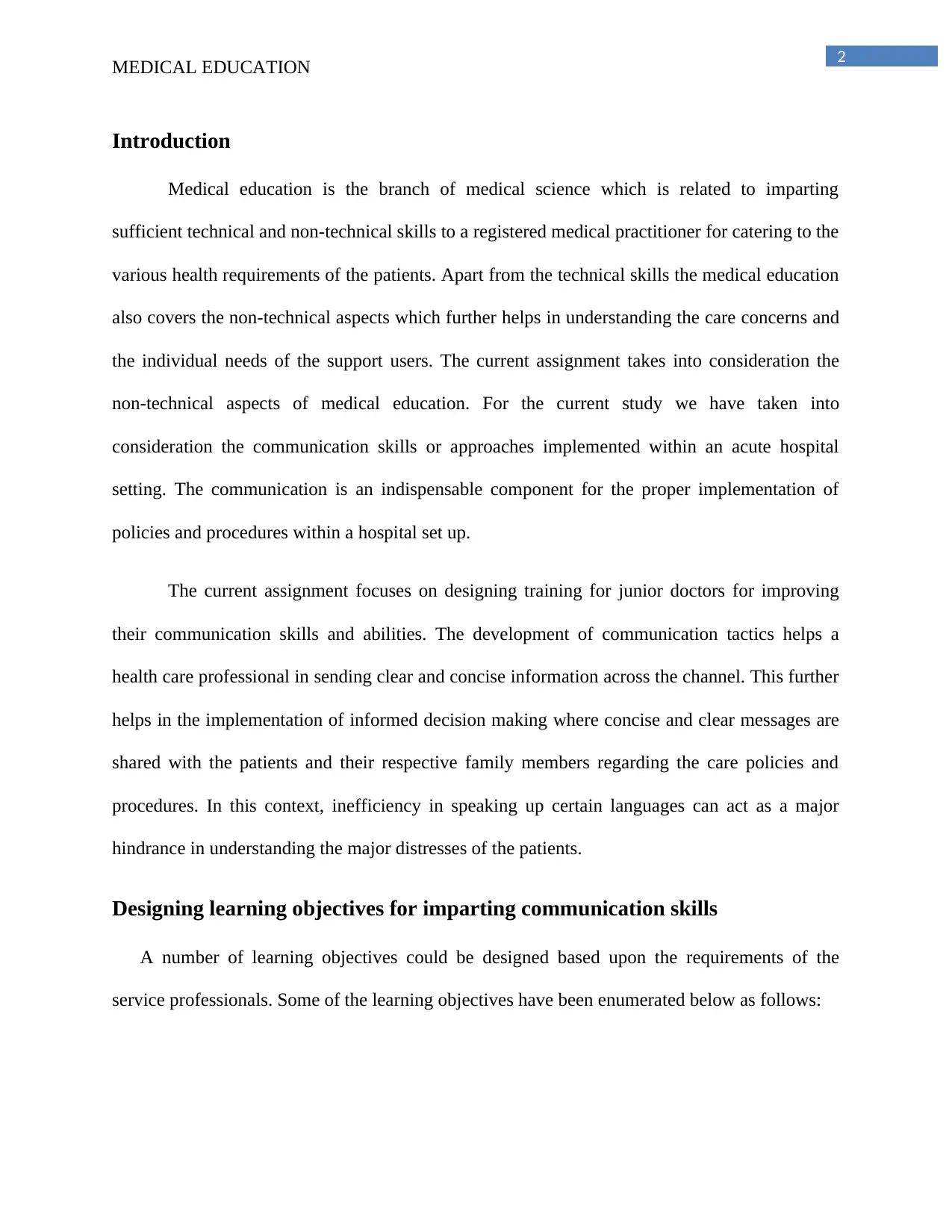
2
MEDICAL EDUCATION
Introduction
Medical education is the branch of medical science which is related to imparting
sufficient technical and non-technical skills to a registered medical practitioner for catering to the
various health requirements of the patients. Apart from the technical skills the medical education
also covers the non-technical aspects which further helps in understanding the care concerns and
the individual needs of the support users. The current assignment takes into consideration the
non-technical aspects of medical education. For the current study we have taken into
consideration the communication skills or approaches implemented within an acute hospital
setting. The communication is an indispensable component for the proper implementation of
policies and procedures within a hospital set up.
The current assignment focuses on designing training for junior doctors for improving
their communication skills and abilities. The development of communication tactics helps a
health care professional in sending clear and concise information across the channel. This further
helps in the implementation of informed decision making where concise and clear messages are
shared with the patients and their respective family members regarding the care policies and
procedures. In this context, inefficiency in speaking up certain languages can act as a major
hindrance in understanding the major distresses of the patients.
Designing learning objectives for imparting communication skills
A number of learning objectives could be designed based upon the requirements of the
service professionals. Some of the learning objectives have been enumerated below as follows:
MEDICAL EDUCATION
Introduction
Medical education is the branch of medical science which is related to imparting
sufficient technical and non-technical skills to a registered medical practitioner for catering to the
various health requirements of the patients. Apart from the technical skills the medical education
also covers the non-technical aspects which further helps in understanding the care concerns and
the individual needs of the support users. The current assignment takes into consideration the
non-technical aspects of medical education. For the current study we have taken into
consideration the communication skills or approaches implemented within an acute hospital
setting. The communication is an indispensable component for the proper implementation of
policies and procedures within a hospital set up.
The current assignment focuses on designing training for junior doctors for improving
their communication skills and abilities. The development of communication tactics helps a
health care professional in sending clear and concise information across the channel. This further
helps in the implementation of informed decision making where concise and clear messages are
shared with the patients and their respective family members regarding the care policies and
procedures. In this context, inefficiency in speaking up certain languages can act as a major
hindrance in understanding the major distresses of the patients.
Designing learning objectives for imparting communication skills
A number of learning objectives could be designed based upon the requirements of the
service professionals. Some of the learning objectives have been enumerated below as follows:
⊘ This is a preview!⊘
Do you want full access?
Subscribe today to unlock all pages.

Trusted by 1+ million students worldwide

3
MEDICAL EDUCATION
To communicate ethically, responsibly and effectively with the patients
The patient and their respective families need to be made a part of the care plans and
designing process. This provides sufficient autonomy to the patients and their respective
families where they could equally participate in the health support programmes. As commented
by Gordon et al. (2012), the implementation of the right to decision making forms the very
foundation of a health care setting. The breach or the violation of any such rights can invite legal
actions against the health care providers.
To communicate effectively within a group to analyse the patient problem and devise a
solution
Effective communication need to be implemented within a group for understanding and
designing of effective strategies for provision of proper care to the patients. However as argued
by Lewis et al. (2012), often geographical or language differences can act as hindrances. This
prevents active exchange of information within a healthcare team. Therefore, active
communication needs to be supported within a group by formulating effective communication
goals and strategies.
To develop interpersonal communication competences
The development of interpersonal communication skills are centred on learning different
body languages for communicating effectively with the patient and their respective families. This
can help the junior doctors communicate easily with the patients and also enhance the bond of
trust between the doctors and the patients. As mentioned by Akaike et al.(2012), use of friendly
gestures helps a healthcare professional in comprehending the complex health care requirements
of the patients.
MEDICAL EDUCATION
To communicate ethically, responsibly and effectively with the patients
The patient and their respective families need to be made a part of the care plans and
designing process. This provides sufficient autonomy to the patients and their respective
families where they could equally participate in the health support programmes. As commented
by Gordon et al. (2012), the implementation of the right to decision making forms the very
foundation of a health care setting. The breach or the violation of any such rights can invite legal
actions against the health care providers.
To communicate effectively within a group to analyse the patient problem and devise a
solution
Effective communication need to be implemented within a group for understanding and
designing of effective strategies for provision of proper care to the patients. However as argued
by Lewis et al. (2012), often geographical or language differences can act as hindrances. This
prevents active exchange of information within a healthcare team. Therefore, active
communication needs to be supported within a group by formulating effective communication
goals and strategies.
To develop interpersonal communication competences
The development of interpersonal communication skills are centred on learning different
body languages for communicating effectively with the patient and their respective families. This
can help the junior doctors communicate easily with the patients and also enhance the bond of
trust between the doctors and the patients. As mentioned by Akaike et al.(2012), use of friendly
gestures helps a healthcare professional in comprehending the complex health care requirements
of the patients.
Paraphrase This Document
Need a fresh take? Get an instant paraphrase of this document with our AI Paraphraser
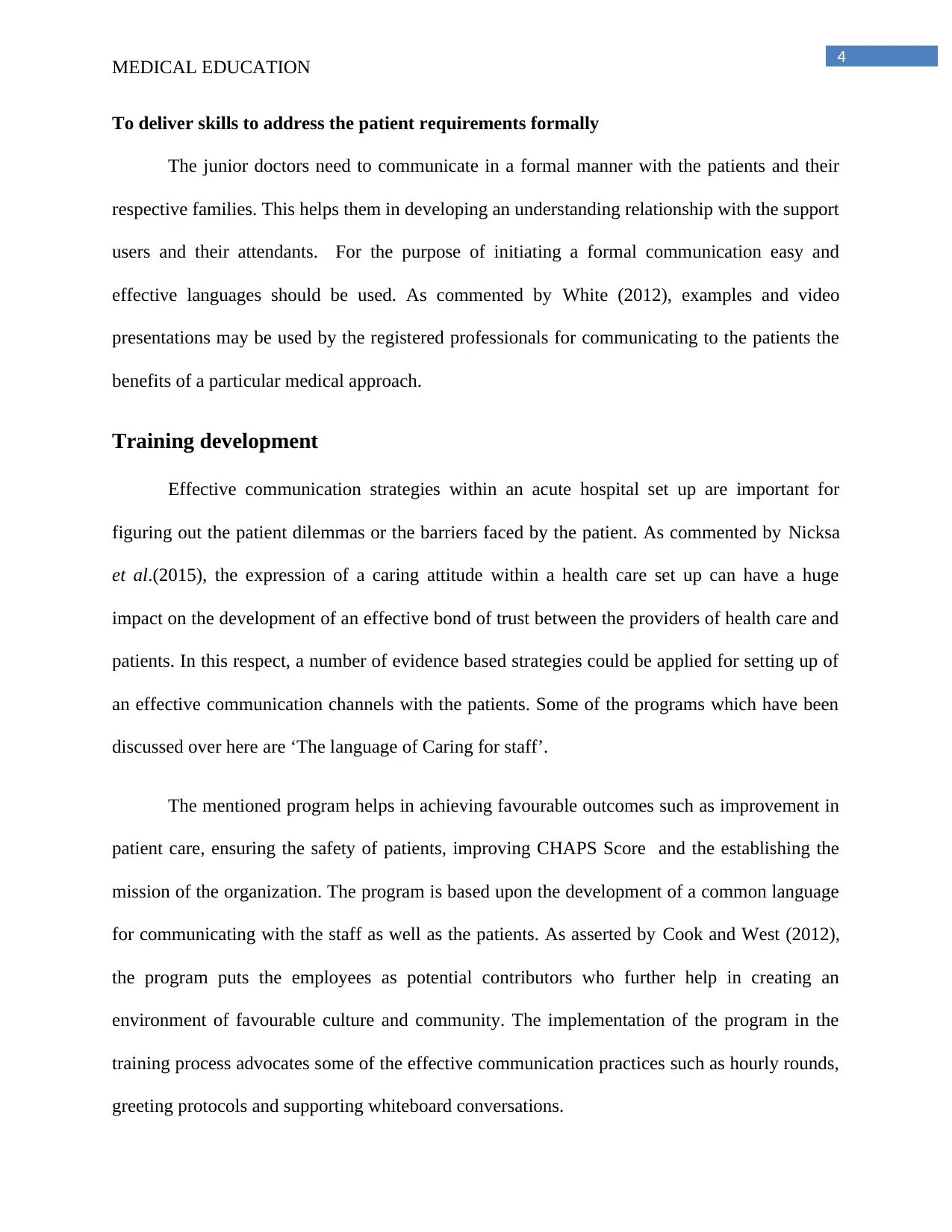
4
MEDICAL EDUCATION
To deliver skills to address the patient requirements formally
The junior doctors need to communicate in a formal manner with the patients and their
respective families. This helps them in developing an understanding relationship with the support
users and their attendants. For the purpose of initiating a formal communication easy and
effective languages should be used. As commented by White (2012), examples and video
presentations may be used by the registered professionals for communicating to the patients the
benefits of a particular medical approach.
Training development
Effective communication strategies within an acute hospital set up are important for
figuring out the patient dilemmas or the barriers faced by the patient. As commented by Nicksa
et al.(2015), the expression of a caring attitude within a health care set up can have a huge
impact on the development of an effective bond of trust between the providers of health care and
patients. In this respect, a number of evidence based strategies could be applied for setting up of
an effective communication channels with the patients. Some of the programs which have been
discussed over here are ‘The language of Caring for staff’.
The mentioned program helps in achieving favourable outcomes such as improvement in
patient care, ensuring the safety of patients, improving CHAPS Score and the establishing the
mission of the organization. The program is based upon the development of a common language
for communicating with the staff as well as the patients. As asserted by Cook and West (2012),
the program puts the employees as potential contributors who further help in creating an
environment of favourable culture and community. The implementation of the program in the
training process advocates some of the effective communication practices such as hourly rounds,
greeting protocols and supporting whiteboard conversations.
MEDICAL EDUCATION
To deliver skills to address the patient requirements formally
The junior doctors need to communicate in a formal manner with the patients and their
respective families. This helps them in developing an understanding relationship with the support
users and their attendants. For the purpose of initiating a formal communication easy and
effective languages should be used. As commented by White (2012), examples and video
presentations may be used by the registered professionals for communicating to the patients the
benefits of a particular medical approach.
Training development
Effective communication strategies within an acute hospital set up are important for
figuring out the patient dilemmas or the barriers faced by the patient. As commented by Nicksa
et al.(2015), the expression of a caring attitude within a health care set up can have a huge
impact on the development of an effective bond of trust between the providers of health care and
patients. In this respect, a number of evidence based strategies could be applied for setting up of
an effective communication channels with the patients. Some of the programs which have been
discussed over here are ‘The language of Caring for staff’.
The mentioned program helps in achieving favourable outcomes such as improvement in
patient care, ensuring the safety of patients, improving CHAPS Score and the establishing the
mission of the organization. The program is based upon the development of a common language
for communicating with the staff as well as the patients. As asserted by Cook and West (2012),
the program puts the employees as potential contributors who further help in creating an
environment of favourable culture and community. The implementation of the program in the
training process advocates some of the effective communication practices such as hourly rounds,
greeting protocols and supporting whiteboard conversations.
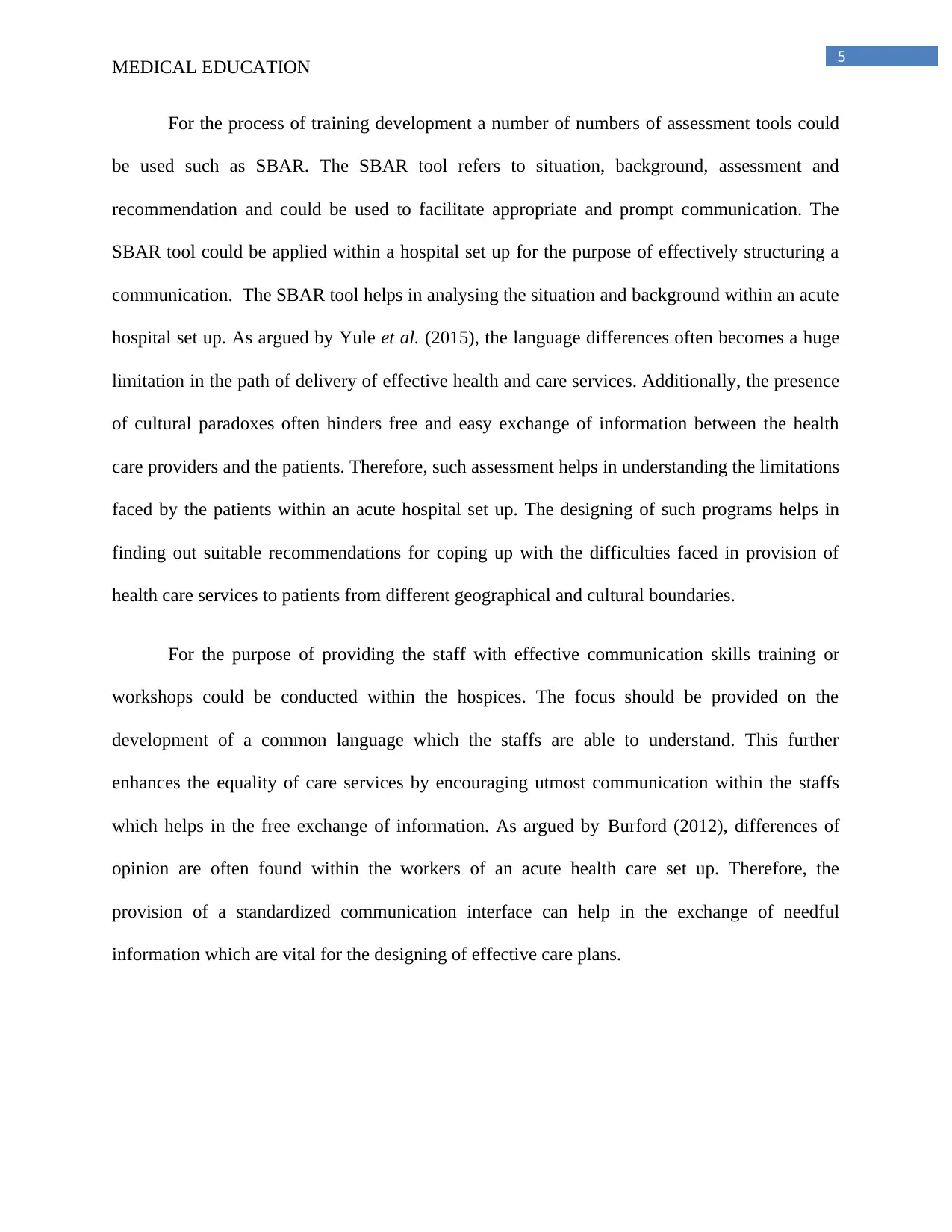
5
MEDICAL EDUCATION
For the process of training development a number of numbers of assessment tools could
be used such as SBAR. The SBAR tool refers to situation, background, assessment and
recommendation and could be used to facilitate appropriate and prompt communication. The
SBAR tool could be applied within a hospital set up for the purpose of effectively structuring a
communication. The SBAR tool helps in analysing the situation and background within an acute
hospital set up. As argued by Yule et al. (2015), the language differences often becomes a huge
limitation in the path of delivery of effective health and care services. Additionally, the presence
of cultural paradoxes often hinders free and easy exchange of information between the health
care providers and the patients. Therefore, such assessment helps in understanding the limitations
faced by the patients within an acute hospital set up. The designing of such programs helps in
finding out suitable recommendations for coping up with the difficulties faced in provision of
health care services to patients from different geographical and cultural boundaries.
For the purpose of providing the staff with effective communication skills training or
workshops could be conducted within the hospices. The focus should be provided on the
development of a common language which the staffs are able to understand. This further
enhances the equality of care services by encouraging utmost communication within the staffs
which helps in the free exchange of information. As argued by Burford (2012), differences of
opinion are often found within the workers of an acute health care set up. Therefore, the
provision of a standardized communication interface can help in the exchange of needful
information which are vital for the designing of effective care plans.
MEDICAL EDUCATION
For the process of training development a number of numbers of assessment tools could
be used such as SBAR. The SBAR tool refers to situation, background, assessment and
recommendation and could be used to facilitate appropriate and prompt communication. The
SBAR tool could be applied within a hospital set up for the purpose of effectively structuring a
communication. The SBAR tool helps in analysing the situation and background within an acute
hospital set up. As argued by Yule et al. (2015), the language differences often becomes a huge
limitation in the path of delivery of effective health and care services. Additionally, the presence
of cultural paradoxes often hinders free and easy exchange of information between the health
care providers and the patients. Therefore, such assessment helps in understanding the limitations
faced by the patients within an acute hospital set up. The designing of such programs helps in
finding out suitable recommendations for coping up with the difficulties faced in provision of
health care services to patients from different geographical and cultural boundaries.
For the purpose of providing the staff with effective communication skills training or
workshops could be conducted within the hospices. The focus should be provided on the
development of a common language which the staffs are able to understand. This further
enhances the equality of care services by encouraging utmost communication within the staffs
which helps in the free exchange of information. As argued by Burford (2012), differences of
opinion are often found within the workers of an acute health care set up. Therefore, the
provision of a standardized communication interface can help in the exchange of needful
information which are vital for the designing of effective care plans.
⊘ This is a preview!⊘
Do you want full access?
Subscribe today to unlock all pages.

Trusted by 1+ million students worldwide
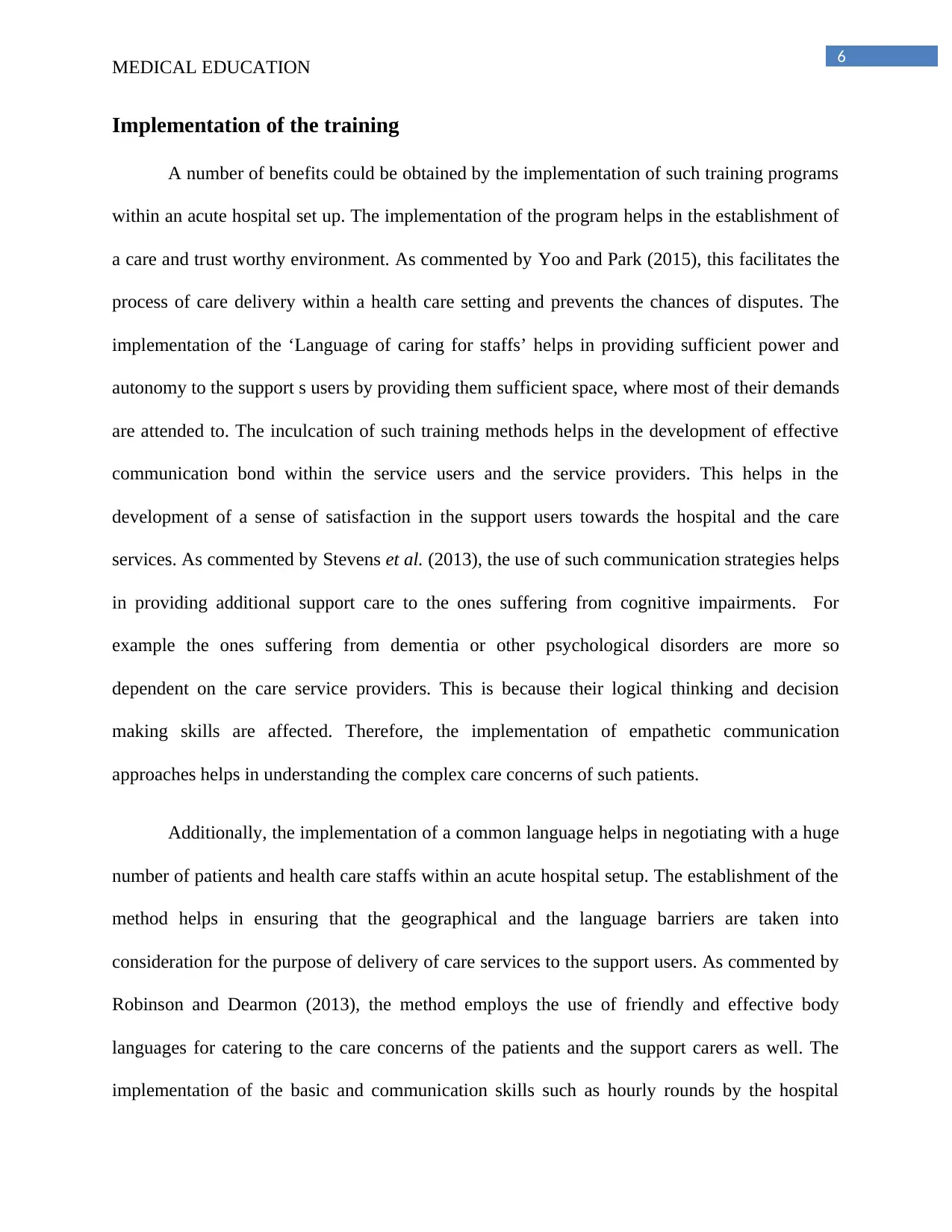
6
MEDICAL EDUCATION
Implementation of the training
A number of benefits could be obtained by the implementation of such training programs
within an acute hospital set up. The implementation of the program helps in the establishment of
a care and trust worthy environment. As commented by Yoo and Park (2015), this facilitates the
process of care delivery within a health care setting and prevents the chances of disputes. The
implementation of the ‘Language of caring for staffs’ helps in providing sufficient power and
autonomy to the support s users by providing them sufficient space, where most of their demands
are attended to. The inculcation of such training methods helps in the development of effective
communication bond within the service users and the service providers. This helps in the
development of a sense of satisfaction in the support users towards the hospital and the care
services. As commented by Stevens et al. (2013), the use of such communication strategies helps
in providing additional support care to the ones suffering from cognitive impairments. For
example the ones suffering from dementia or other psychological disorders are more so
dependent on the care service providers. This is because their logical thinking and decision
making skills are affected. Therefore, the implementation of empathetic communication
approaches helps in understanding the complex care concerns of such patients.
Additionally, the implementation of a common language helps in negotiating with a huge
number of patients and health care staffs within an acute hospital setup. The establishment of the
method helps in ensuring that the geographical and the language barriers are taken into
consideration for the purpose of delivery of care services to the support users. As commented by
Robinson and Dearmon (2013), the method employs the use of friendly and effective body
languages for catering to the care concerns of the patients and the support carers as well. The
implementation of the basic and communication skills such as hourly rounds by the hospital
MEDICAL EDUCATION
Implementation of the training
A number of benefits could be obtained by the implementation of such training programs
within an acute hospital set up. The implementation of the program helps in the establishment of
a care and trust worthy environment. As commented by Yoo and Park (2015), this facilitates the
process of care delivery within a health care setting and prevents the chances of disputes. The
implementation of the ‘Language of caring for staffs’ helps in providing sufficient power and
autonomy to the support s users by providing them sufficient space, where most of their demands
are attended to. The inculcation of such training methods helps in the development of effective
communication bond within the service users and the service providers. This helps in the
development of a sense of satisfaction in the support users towards the hospital and the care
services. As commented by Stevens et al. (2013), the use of such communication strategies helps
in providing additional support care to the ones suffering from cognitive impairments. For
example the ones suffering from dementia or other psychological disorders are more so
dependent on the care service providers. This is because their logical thinking and decision
making skills are affected. Therefore, the implementation of empathetic communication
approaches helps in understanding the complex care concerns of such patients.
Additionally, the implementation of a common language helps in negotiating with a huge
number of patients and health care staffs within an acute hospital setup. The establishment of the
method helps in ensuring that the geographical and the language barriers are taken into
consideration for the purpose of delivery of care services to the support users. As commented by
Robinson and Dearmon (2013), the method employs the use of friendly and effective body
languages for catering to the care concerns of the patients and the support carers as well. The
implementation of the basic and communication skills such as hourly rounds by the hospital
Paraphrase This Document
Need a fresh take? Get an instant paraphrase of this document with our AI Paraphraser

7
MEDICAL EDUCATION
staffs, friendly greetings. Some of these practices help in maintaining a positive work culture
within the hospital environment. As commented by Liton (2012), maintaining a positive work
culture helps in potential employee retention. The implementation of the program needs
sufficient cooperation and participation from the hospital staff and employees. A prior
knowledge regarding the implementation of such programs needs to be provided to the hospital
staff. As commented by Kitchen (2012), organizing of educational seminars can be helpful in
providing sufficient clearance to the hospital staffs regrading the method of effective
communication. The organizing of such seminars also helps in implementation of precautionary
measures within a clinical set up.
Formative and summative evaluation
Reports and evidences have suggested that communication gap between the physicians
and the support users can result in obstacles in the care delivery processes. Therefore, as
commented by Nicksa et al. (2015), efficient communication approaches could help in the
establishment of optimum health standards of the support users. In this respect, a formative and
summative evaluation of the communication skills can be done for deciphering the loopholes
within the implemented communication tactics and approaches. The formative assessment
methods could be used for evaluating the strengths and weaknesses of the learning approaches
inculcated in the training session of the junior doctors (Lund et al. 2012). The formative
assessment is informal in approaches and is often integrated within the course curriculum (Frich
et al. 2015).
The conducting of such assessments helps in identifying the loopholes and designing new
communication approaches and skills. The summative assessment is much broader in its scope
and nature of approach. This particular method of assessment helps in identification of the
MEDICAL EDUCATION
staffs, friendly greetings. Some of these practices help in maintaining a positive work culture
within the hospital environment. As commented by Liton (2012), maintaining a positive work
culture helps in potential employee retention. The implementation of the program needs
sufficient cooperation and participation from the hospital staff and employees. A prior
knowledge regarding the implementation of such programs needs to be provided to the hospital
staff. As commented by Kitchen (2012), organizing of educational seminars can be helpful in
providing sufficient clearance to the hospital staffs regrading the method of effective
communication. The organizing of such seminars also helps in implementation of precautionary
measures within a clinical set up.
Formative and summative evaluation
Reports and evidences have suggested that communication gap between the physicians
and the support users can result in obstacles in the care delivery processes. Therefore, as
commented by Nicksa et al. (2015), efficient communication approaches could help in the
establishment of optimum health standards of the support users. In this respect, a formative and
summative evaluation of the communication skills can be done for deciphering the loopholes
within the implemented communication tactics and approaches. The formative assessment
methods could be used for evaluating the strengths and weaknesses of the learning approaches
inculcated in the training session of the junior doctors (Lund et al. 2012). The formative
assessment is informal in approaches and is often integrated within the course curriculum (Frich
et al. 2015).
The conducting of such assessments helps in identifying the loopholes and designing new
communication approaches and skills. The summative assessment is much broader in its scope
and nature of approach. This particular method of assessment helps in identification of the

8
MEDICAL EDUCATION
incompetent health care providers. Thus, the implementation of such method helps in enhancing
the quality and standards of the health care services. The summative assessment is much more
comprehensive in nature whereby the overall skills possessed by a health care professional are
taken into consideration. The evaluative process helps in addressing the knowledge and the level
of skills possessed by the health care professionals. Some of the effective practices such as mini
clinical evaluation exercises has becomes a useful tool to analyse the performance of the health
care providers.
Conclusion
The current assignment focuses on the use and efficiency of communication aspects
within a hospital setting. The learning and implementation of the effective communication skills
helps in understanding the grievances faced by the patients more effectively. However, for the
inculcation of appropriate communication approaches and policies within a hospital set up
sufficient amount of training and development is required. A number of communication
development skills have been discussed in the present context such as the SBAR tool and the
language of caring for staff. The communication methods not only help in the management and
prevention of disputes within a hospital set up. However, the inculcation of empathetic methods
also helps in controlling the ethical barriers.
Additionally, the implementation of the communication methods and approaches also
helps dealing with a huge number of restrictions within an acute hospital set up. The inculcation
of friendly body languages helps in connecting better with the patients and their respective
families. The assignment also takes into consideration the summative and formative assessments
which helps in understanding the loopholes within the training and development processes.
MEDICAL EDUCATION
incompetent health care providers. Thus, the implementation of such method helps in enhancing
the quality and standards of the health care services. The summative assessment is much more
comprehensive in nature whereby the overall skills possessed by a health care professional are
taken into consideration. The evaluative process helps in addressing the knowledge and the level
of skills possessed by the health care professionals. Some of the effective practices such as mini
clinical evaluation exercises has becomes a useful tool to analyse the performance of the health
care providers.
Conclusion
The current assignment focuses on the use and efficiency of communication aspects
within a hospital setting. The learning and implementation of the effective communication skills
helps in understanding the grievances faced by the patients more effectively. However, for the
inculcation of appropriate communication approaches and policies within a hospital set up
sufficient amount of training and development is required. A number of communication
development skills have been discussed in the present context such as the SBAR tool and the
language of caring for staff. The communication methods not only help in the management and
prevention of disputes within a hospital set up. However, the inculcation of empathetic methods
also helps in controlling the ethical barriers.
Additionally, the implementation of the communication methods and approaches also
helps dealing with a huge number of restrictions within an acute hospital set up. The inculcation
of friendly body languages helps in connecting better with the patients and their respective
families. The assignment also takes into consideration the summative and formative assessments
which helps in understanding the loopholes within the training and development processes.
⊘ This is a preview!⊘
Do you want full access?
Subscribe today to unlock all pages.

Trusted by 1+ million students worldwide
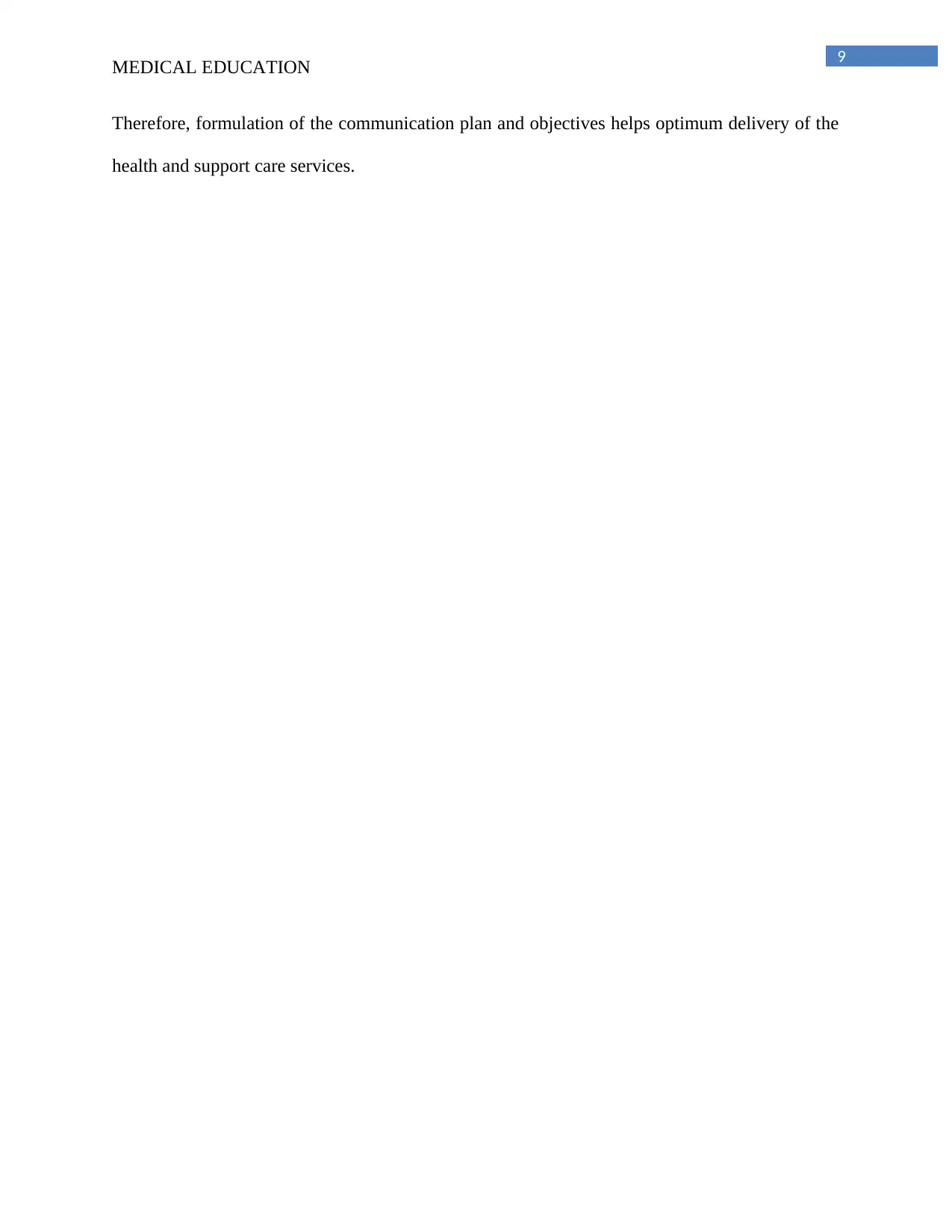
9
MEDICAL EDUCATION
Therefore, formulation of the communication plan and objectives helps optimum delivery of the
health and support care services.
MEDICAL EDUCATION
Therefore, formulation of the communication plan and objectives helps optimum delivery of the
health and support care services.
Paraphrase This Document
Need a fresh take? Get an instant paraphrase of this document with our AI Paraphraser
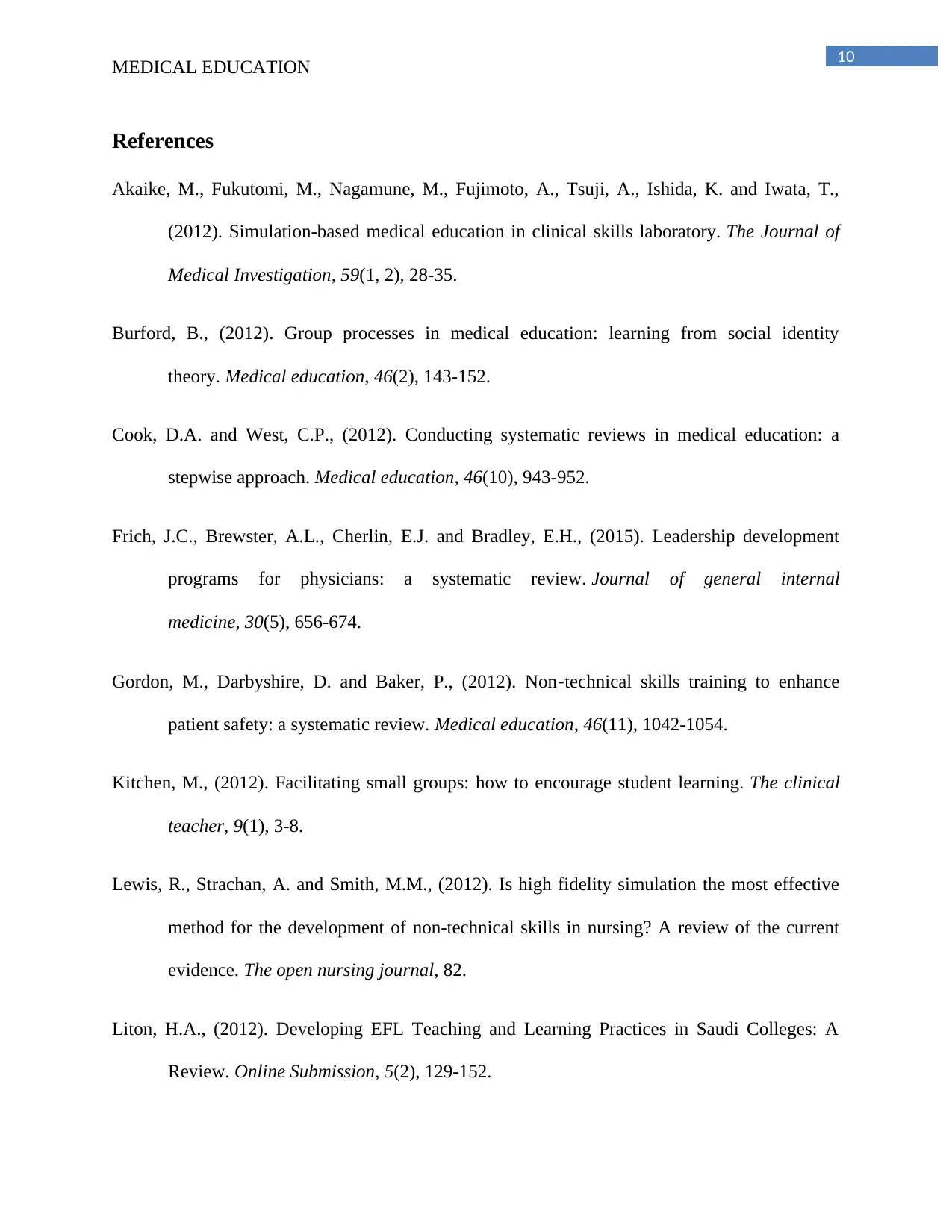
10
MEDICAL EDUCATION
References
Akaike, M., Fukutomi, M., Nagamune, M., Fujimoto, A., Tsuji, A., Ishida, K. and Iwata, T.,
(2012). Simulation-based medical education in clinical skills laboratory. The Journal of
Medical Investigation, 59(1, 2), 28-35.
Burford, B., (2012). Group processes in medical education: learning from social identity
theory. Medical education, 46(2), 143-152.
Cook, D.A. and West, C.P., (2012). Conducting systematic reviews in medical education: a
stepwise approach. Medical education, 46(10), 943-952.
Frich, J.C., Brewster, A.L., Cherlin, E.J. and Bradley, E.H., (2015). Leadership development
programs for physicians: a systematic review. Journal of general internal
medicine, 30(5), 656-674.
Gordon, M., Darbyshire, D. and Baker, P., (2012). Non‐technical skills training to enhance
patient safety: a systematic review. Medical education, 46(11), 1042-1054.
Kitchen, M., (2012). Facilitating small groups: how to encourage student learning. The clinical
teacher, 9(1), 3-8.
Lewis, R., Strachan, A. and Smith, M.M., (2012). Is high fidelity simulation the most effective
method for the development of non-technical skills in nursing? A review of the current
evidence. The open nursing journal, 82.
Liton, H.A., (2012). Developing EFL Teaching and Learning Practices in Saudi Colleges: A
Review. Online Submission, 5(2), 129-152.
MEDICAL EDUCATION
References
Akaike, M., Fukutomi, M., Nagamune, M., Fujimoto, A., Tsuji, A., Ishida, K. and Iwata, T.,
(2012). Simulation-based medical education in clinical skills laboratory. The Journal of
Medical Investigation, 59(1, 2), 28-35.
Burford, B., (2012). Group processes in medical education: learning from social identity
theory. Medical education, 46(2), 143-152.
Cook, D.A. and West, C.P., (2012). Conducting systematic reviews in medical education: a
stepwise approach. Medical education, 46(10), 943-952.
Frich, J.C., Brewster, A.L., Cherlin, E.J. and Bradley, E.H., (2015). Leadership development
programs for physicians: a systematic review. Journal of general internal
medicine, 30(5), 656-674.
Gordon, M., Darbyshire, D. and Baker, P., (2012). Non‐technical skills training to enhance
patient safety: a systematic review. Medical education, 46(11), 1042-1054.
Kitchen, M., (2012). Facilitating small groups: how to encourage student learning. The clinical
teacher, 9(1), 3-8.
Lewis, R., Strachan, A. and Smith, M.M., (2012). Is high fidelity simulation the most effective
method for the development of non-technical skills in nursing? A review of the current
evidence. The open nursing journal, 82.
Liton, H.A., (2012). Developing EFL Teaching and Learning Practices in Saudi Colleges: A
Review. Online Submission, 5(2), 129-152.
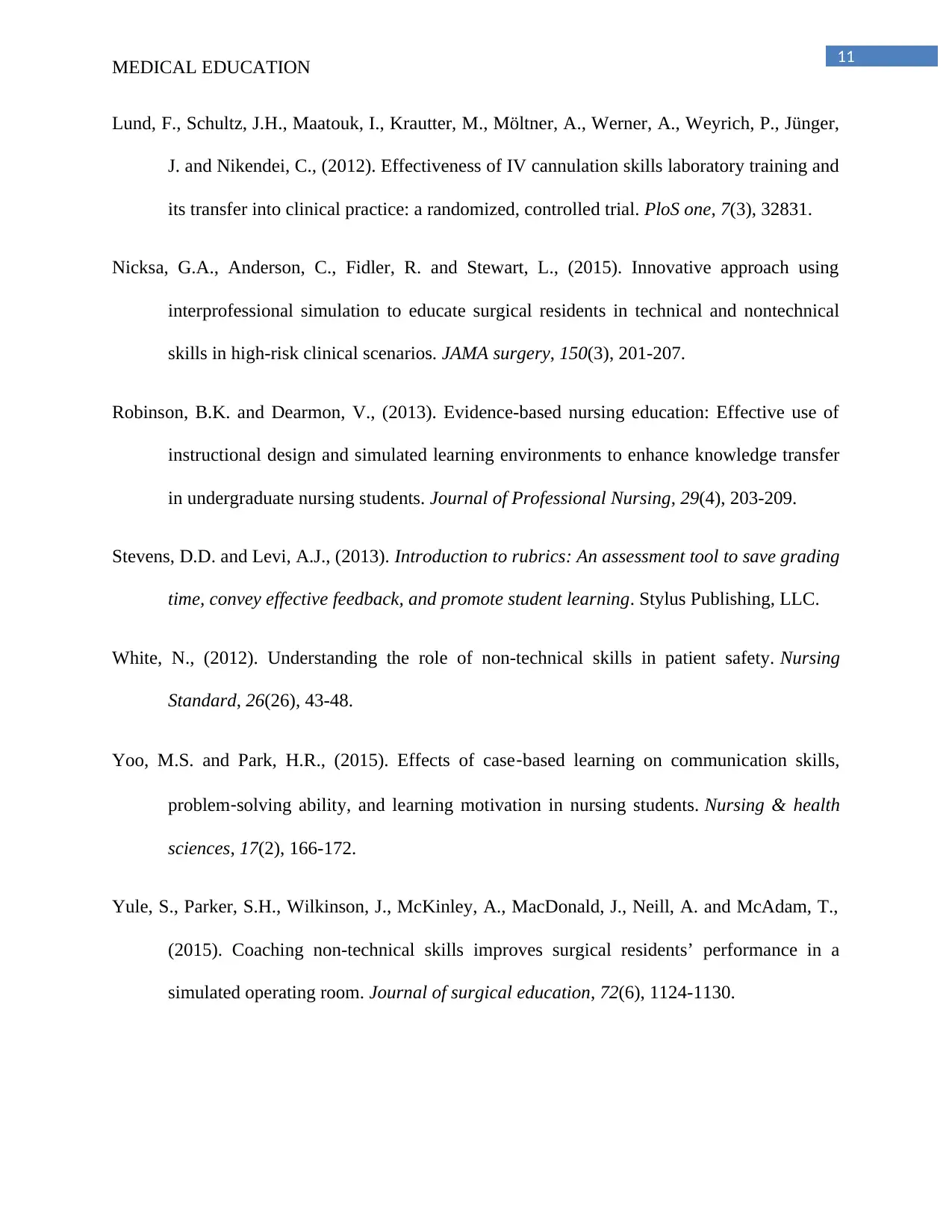
11
MEDICAL EDUCATION
Lund, F., Schultz, J.H., Maatouk, I., Krautter, M., Möltner, A., Werner, A., Weyrich, P., Jünger,
J. and Nikendei, C., (2012). Effectiveness of IV cannulation skills laboratory training and
its transfer into clinical practice: a randomized, controlled trial. PloS one, 7(3), 32831.
Nicksa, G.A., Anderson, C., Fidler, R. and Stewart, L., (2015). Innovative approach using
interprofessional simulation to educate surgical residents in technical and nontechnical
skills in high-risk clinical scenarios. JAMA surgery, 150(3), 201-207.
Robinson, B.K. and Dearmon, V., (2013). Evidence-based nursing education: Effective use of
instructional design and simulated learning environments to enhance knowledge transfer
in undergraduate nursing students. Journal of Professional Nursing, 29(4), 203-209.
Stevens, D.D. and Levi, A.J., (2013). Introduction to rubrics: An assessment tool to save grading
time, convey effective feedback, and promote student learning. Stylus Publishing, LLC.
White, N., (2012). Understanding the role of non-technical skills in patient safety. Nursing
Standard, 26(26), 43-48.
Yoo, M.S. and Park, H.R., (2015). Effects of case‐based learning on communication skills,
problem‐solving ability, and learning motivation in nursing students. Nursing & health
sciences, 17(2), 166-172.
Yule, S., Parker, S.H., Wilkinson, J., McKinley, A., MacDonald, J., Neill, A. and McAdam, T.,
(2015). Coaching non-technical skills improves surgical residents’ performance in a
simulated operating room. Journal of surgical education, 72(6), 1124-1130.
MEDICAL EDUCATION
Lund, F., Schultz, J.H., Maatouk, I., Krautter, M., Möltner, A., Werner, A., Weyrich, P., Jünger,
J. and Nikendei, C., (2012). Effectiveness of IV cannulation skills laboratory training and
its transfer into clinical practice: a randomized, controlled trial. PloS one, 7(3), 32831.
Nicksa, G.A., Anderson, C., Fidler, R. and Stewart, L., (2015). Innovative approach using
interprofessional simulation to educate surgical residents in technical and nontechnical
skills in high-risk clinical scenarios. JAMA surgery, 150(3), 201-207.
Robinson, B.K. and Dearmon, V., (2013). Evidence-based nursing education: Effective use of
instructional design and simulated learning environments to enhance knowledge transfer
in undergraduate nursing students. Journal of Professional Nursing, 29(4), 203-209.
Stevens, D.D. and Levi, A.J., (2013). Introduction to rubrics: An assessment tool to save grading
time, convey effective feedback, and promote student learning. Stylus Publishing, LLC.
White, N., (2012). Understanding the role of non-technical skills in patient safety. Nursing
Standard, 26(26), 43-48.
Yoo, M.S. and Park, H.R., (2015). Effects of case‐based learning on communication skills,
problem‐solving ability, and learning motivation in nursing students. Nursing & health
sciences, 17(2), 166-172.
Yule, S., Parker, S.H., Wilkinson, J., McKinley, A., MacDonald, J., Neill, A. and McAdam, T.,
(2015). Coaching non-technical skills improves surgical residents’ performance in a
simulated operating room. Journal of surgical education, 72(6), 1124-1130.
⊘ This is a preview!⊘
Do you want full access?
Subscribe today to unlock all pages.

Trusted by 1+ million students worldwide
1 out of 12
Related Documents
Your All-in-One AI-Powered Toolkit for Academic Success.
+13062052269
info@desklib.com
Available 24*7 on WhatsApp / Email
![[object Object]](/_next/static/media/star-bottom.7253800d.svg)
Unlock your academic potential
Copyright © 2020–2025 A2Z Services. All Rights Reserved. Developed and managed by ZUCOL.




